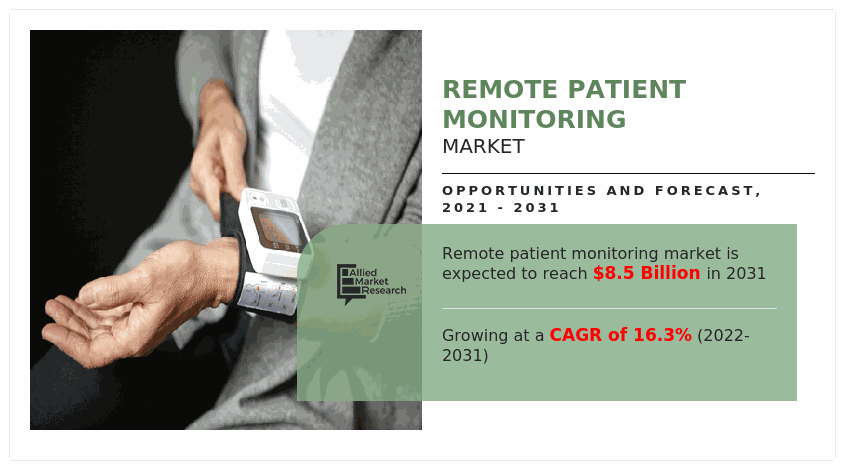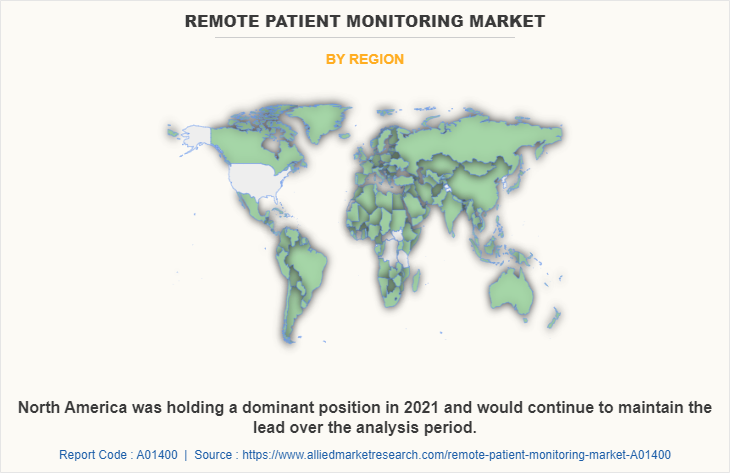
Remote Patient Monitoring Market Poised for $8.5 Billion by 2031, Fueled by a Sturdy 16.3% CAGR

According to a recent report published by Allied Market Research, the global remote patient monitoring market experienced remarkable growth, garnering $1.9 billion in 2021. Projections indicate that by 2031, this market is estimated to reach a staggering $8.5 billion, with a compound annual growth rate (CAGR) of 16.3% from 2022 to 2031. This exponential growth trajectory underscores the increasing adoption and acceptance of RPM solutions worldwide.
The report, titled “Global Remote Patient Monitoring Market Research Report 2024,” offers comprehensive insights into the dynamics shaping the RPM landscape. Industry experts and researchers provide meticulous analysis, delving into growth drivers, challenges, trends, and opportunities that define the market’s trajectory.
Get PDF Sample Copy of Report: (Including Full TOC, List of Tables & Figures, Chart):https://www.alliedmarketresearch.com/request-sample/1727
One of the key drivers propelling the growth of remote patient monitoring is its ability to transcend geographical barriers and deliver healthcare services remotely. By utilizing digital technologies such as wearables, sensors, and mobile devices, RPM enables healthcare providers to collect real-time health data, including vital signs like heart rate, blood pressure, glucose levels, and oxygen saturation. This wealth of data empowers healthcare teams to monitor patients’ health proactively and intervene promptly when necessary, thereby improving patient outcomes and reducing the likelihood of hospital readmissions.
Moreover, remote patient monitoring fosters greater patient engagement and empowerment by allowing individuals to actively participate in their healthcare journey. Patients can conveniently access quality care from the comfort of their homes, eliminating the need for frequent visits to healthcare facilities. This not only enhances convenience but also promotes adherence to treatment plans and fosters a sense of autonomy and control over one’s health.
However, amidst the promising prospects of RPM, certain challenges and limitations persist. Factors such as data privacy concerns, interoperability issues, and regulatory complexities pose hurdles to widespread adoption. Additionally, the efficacy of remote monitoring solutions heavily relies on seamless integration into existing healthcare workflows and adequate training for both healthcare providers and patients.
Despite these challenges, the future outlook for the global remote patient monitoring market remains optimistic. As technological innovations continue to evolve and healthcare stakeholders embrace a patient-centric approach, the adoption of RPM is poised to accelerate further. From chronic disease management to post-operative care and wellness monitoring, remote patient monitoring is revolutionizing healthcare delivery, paving the way for a more connected, proactive, and efficient healthcare ecosystem.
Leading players of the global remote patient monitoring market analyzed in the research include Abott Laboratories, Boston Scientific Inc., Biotronik SE Co. KG, General Electric, Datos Health, Johnson & Johnson, Honey Well International, Medtronic, Koninklijike Philips N.V., and Nihon Kohden.

In the dynamic landscape of the global remote patient monitoring (RPM) market, regional dynamics play a pivotal role in shaping the industry’s trajectory. According to recent data, North America emerged as a frontrunner in 2020, capturing the highest share of the market, contributing to approximately two-fifths of the total market share. Projections indicate that North America is poised to maintain its dominance, retaining the highest share by 2030. However, the Asia-Pacific region is expected to exhibit the fastest compound annual growth rate (CAGR) of 17.2% during the forecast period, underscoring its potential as a burgeoning market for remote patient monitoring solutions.
North America’s prominent position in the remote patient monitoring market can be attributed to several factors, including robust healthcare infrastructure, technological advancements, and increasing adoption of digital health solutions. The region boasts a mature healthcare ecosystem, characterized by a strong emphasis on innovation and patient-centric care. Moreover, favorable reimbursement policies and growing awareness about the benefits of remote patient monitoring have propelled the uptake of RPM solutions among healthcare providers and patients alike. As a result, North America continues to serve as a key revenue generator for market players, with sustained investments in research and development driving continuous innovation in the field of remote patient monitoring.
For Purchase Inquiry-https://www.alliedmarketresearch.com/purchase-enquiry/1727
Editor Details
-
Company:
- The Wire Times
